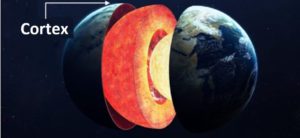Layers Of The Earth Crust With Characteristics, Formation, Importance, Moments And Dynamic
We explain what the Earth’s crust is, layers of the earth crust, how it formed, its movement and other characteristics. In addition, oceanic and continental crust.
-
What is the Earth’s crust?
The Earth’s crust is the most superficial layer on planet Earth . It is the outermost, thinnest and most recent of the Earth’s layers . Is the layer on which inhabit the living things , even those that penetrate into the deeper layers of the soil.
The Earth’s crust is part, together with the Earth’s mantle and the Earth’s core, of the so-called geosphere , which is the solid part of the planet. The crust extends from the surface to an average depth of 35 kilometers . The depth is taken on average since it varies depending on whether it is:
- Oceanic crust . It covers 55% of the planet’s surface, located thousands of meters deep under the ocean , and is thinner than the continental one (with a thickness of 5 km at the ocean floor).
- Continental crust . Of a heterogeneous nature, since it is formed by rocks of different origins, the most abundant minerals being quartz, feldspars and micas. Its thickness is much greater, reaching 70 km in mountainous areas.
Earth is the only known rocky planet that has a heterogeneous crust from a chemical and physical point of view, since they were produced through different geological processes.
-
Characteristics of the Earth’s crust

The Earth’s crust represents less than 1% of the total volume of the planet . However, it is all that we know directly, since it extends up to 35 kilometers towards the core, of which just 12.2 km were excavated with the deepest well in history, the Kola Super Deep Well (KSDB), the work of the former Soviet Union .
The crust is the top of the lithosphere , along with the top of the mantle, above the Mohorovicic discontinuity. Since it is much less dense than the mantle, the crust “floats” on top.
As the depth increases, the temperature also rises , ranging between 200 and 400 ° C, at a rate of 30 ° C per kilometer of depth.
The most abundant chemical elements in the composition of the crust are: oxygen (46.6%), silicon (27.7%), aluminum (8.1%), iron (5.0%), calcium (3.6 %), sodium (2.8%), potassium (2.6%) and magnesium (1.5%). The rest of the volume of the crust is represented by water and other scarce elements, adding less than 1% of its composition.
-
Formation of the Earth’s crust
In the planet’s geological history, the first earth crust was formed from 4400 to 4.55 billion years ago . Since then their volumes have been increasing over time.
As terrestrial conditions stabilized and the planet cooled, new layers of crust emerged to occupy a considerable volume 2.5 billion years ago, largely thanks to two major geological events: one 2.5 billion-2700 million years ago. , and another 1700-1900 million years ago.
However, the Earth’s crust is constantly forming . For this, portions of it sink into the mantle (subduction) to melt into the underground liquid magma, while other new portions emerge in the expansion centers of the oceanic crust.
The continental crust has an average age of 2 million years , which makes it much older than the oceanic crust.
-
Movement and dynamics of the Earth’s crust

The earth’s crust is far from static. The plates that compose it are floating on the mantle , made up of pasty materials under enormous pressure. Therefore, a slow displacement of the crust occurs, which is known as tectonic dynamics.
Thus, the different portions of the crust rub and collide, putting pressure on each other and giving rise to the orogenesis or creation of mountains , as the crust folds and bulges. In this way the relief depends largely on the movement of the crust.
Similarly, depressions or tectonic failures can also be generated, when one plate is submerged below the other, liquefying and increasing the internal pressure of the magma to exit. This is how volcanoes arise .
These movements of the Earth’s crust also give rise to earthquakes and tremors , since the friction between the tectonic plates produces seismic waves that are transmitted to the surface, sometimes with devastating effects.
Similarly, they originate continental drift , which is the movement of continental masses over time, from primitive supercontinents (such as Pangea ) to the current configuration.
-
Layers of the Earth crust
The Earth’s crust is a relatively homogeneous layer, that is, it has no layers or subdivisions . The only way to tell the difference is between the thicker, older and more robust continental crust and the younger, thinner and more mobile oceanic crust.
-
Importance of the Earth’s crust
The Earth’s crust is a vital area of the planet. For starters, that’s where life takes place ( biosphere ), the only phenomenon of our planet in the Solar System.
Also at this point dry and warm rocks can react with the water and oxygen that abound on the surface. In the crust new forms of rocks and minerals arise that make up the mineral wealth and abundance of our environment.
Furthermore, orogenesis would not be possible without the movements of the crust , nor the complex dynamics of geological changes that this implies, and therefore, chemical cycles such as that of water , which requires mountains to flow in rivers towards the sea.





